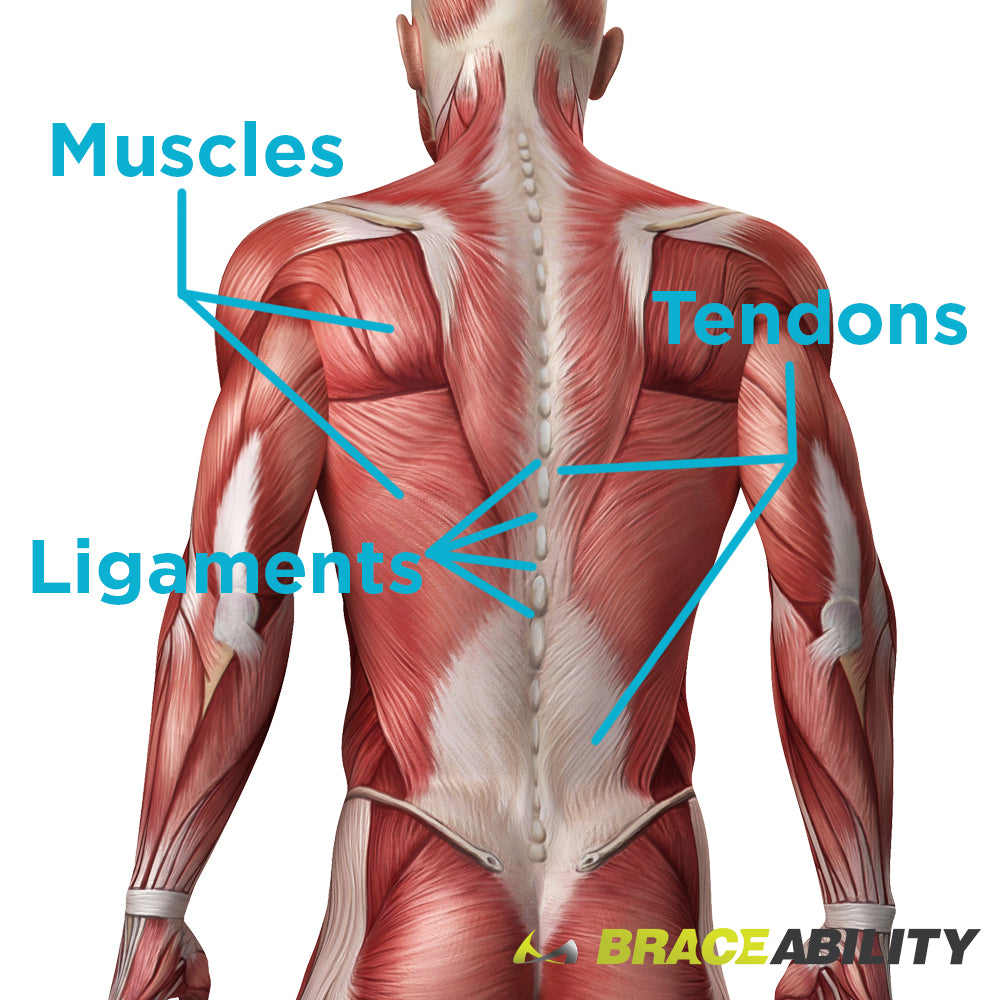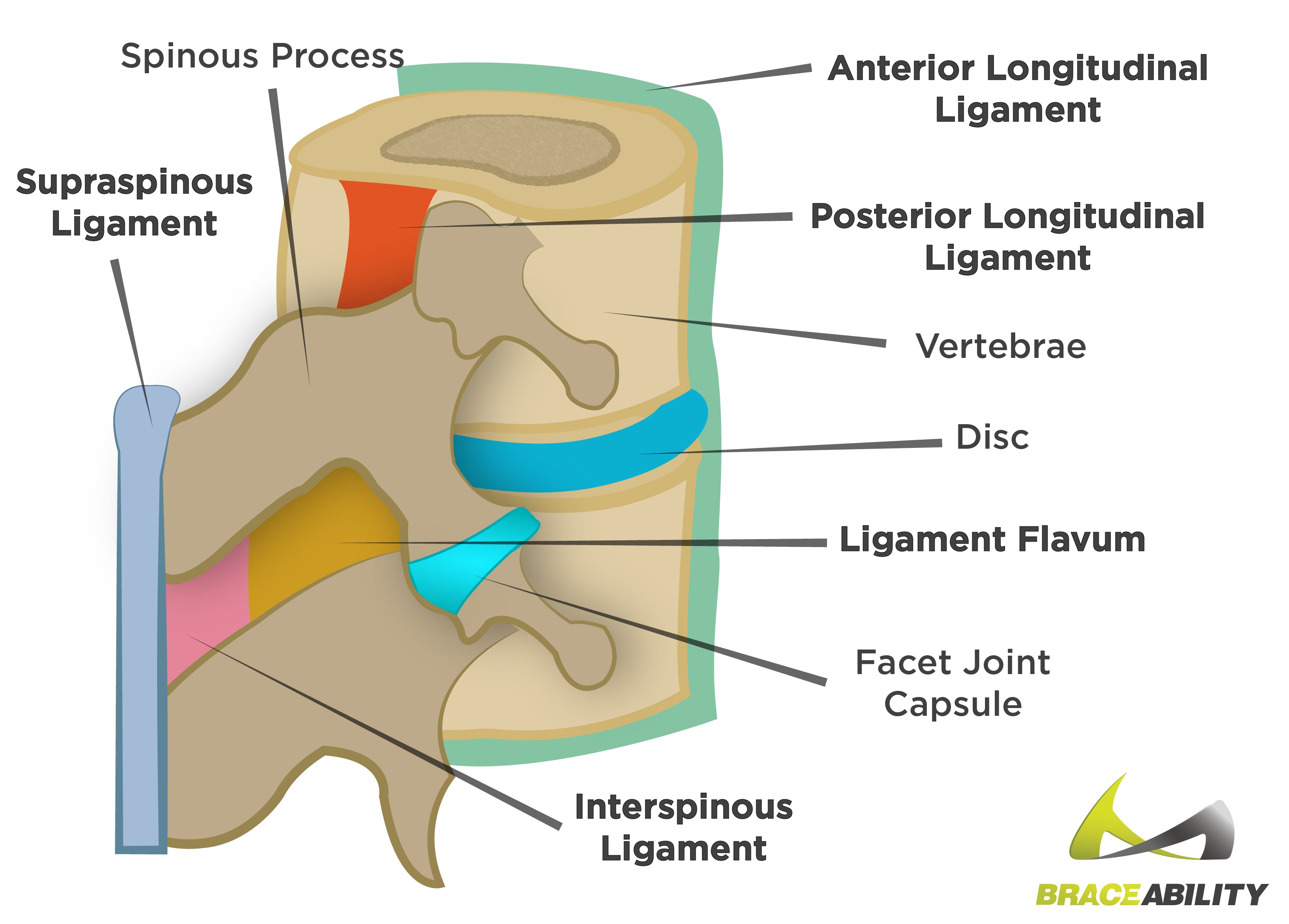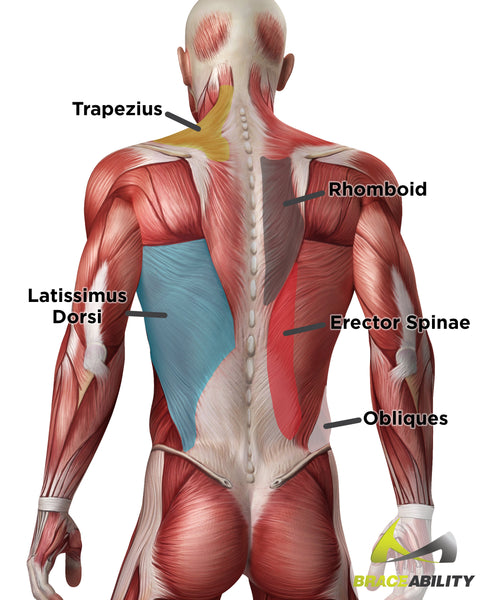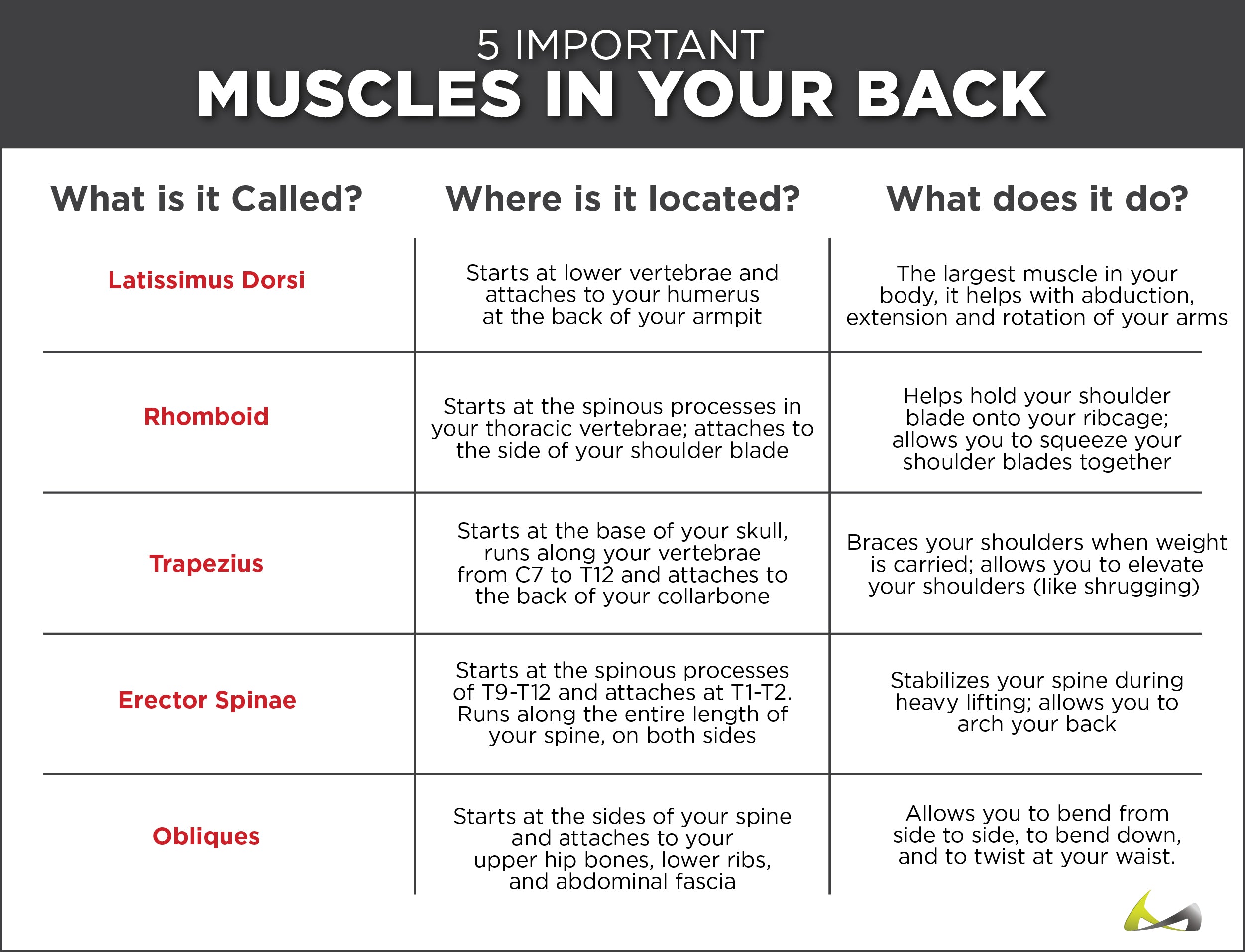Back Muscle Tear, Pull, or Strain
Most of you in your life will experience pain in your back either in your lumbar, thoracic, or cervical spine. For many individuals, the cause of your back discomfort is a result of a pulled or strained muscle in your back, more commonly your lower back region. A muscle strain can vary in severity; some may cause intense pain while others may experience mild pain.
Ligaments vs. Muscles in Your Back
Let’s start by breaking down the difference between ligaments, tendons, and muscles - as these body parts are commonly confused. They are in fact different, but all three work together to support your spine and to help protect it from injury.
The 3 Moving Parts of your Back & Spine
- Muscles - These bundles of stretchy, fibrous tissue are crucial for allowing your body move and maintain different positions. They are connected to your bones and joints by tendons.
- Tendons - These cords of sturdy, tough fibrous collagen tissue attach your muscles to your bones. They are strong, yet still flexible, and your muscles couldn’t move your bones and joints without them!
- Ligaments - These slightly elastic fibrous tissues connect two or more bones together. They help stabilize your joints while you are sitting or standing still, and while you are moving they help prevent excessive movement injuries such as hyperextension and hyperflexion.
To summarize, your spine is held up by tendons, muscles, and ligaments. You need all of them to move properly, and they are all very prone to over-stretching, twisting, and tearing, which causes damage and injury.

Ligaments in Your Spine

Ligaments are fibrous tissues that connect two or more bones together. They help stabilize your joints while you are sitting or standing still, and while you are moving they help prevent excessive movement injuries such as hyperextension and hyperflexion.
Your spinal ligaments help protect your vertebrae, keep them in their proper position and help you stay upright. Ligaments are slightly elastic, but you can overstretch them through sudden or extreme movements, and you can even tear them.
The 5 Main Ligaments in Your Spine and What They Do:

- Anterior Longitudinal Ligament: This ligament runs down the anterior (front) side of your spine, and has three different layers - superficial, intermediate, and deep. This ligament helps hold your vertebrae and the discs in your spine together, preventing excessive extension in this region.
- Posterior Longitudinal Ligament: This ligament runs down the entire back of your spine, holds vertebrae and discs together and prevents excessive flexion (forward bending).
- Ligamentum Flavum: This ligament connects to your vertebrae all the way down to the first segment of the sacrum (the base of your spine). They are located inside of the vertebral canal and consist of yellow elastic tissue and fibers. This ligament helps your body's postural stance and prevents buckling in the ligaments that are going into the spinal canal.
- Interspinous Ligament: This ligament is located in between the spinous processes - those “fins” or bony projections on the back of each vertebra. It holds your vertebrae together and prevents your spine from extending beyond its limits
- Supraspinous Ligament: The supraspinous ligament runs along the outside of the spinous processes. It connects the tips of those vertebrae “fins” to help hold your vertebrae together and limit hyperflexion.
5 IMPORTANT
|
||
| What is it called? | Where is it located? | What does it do? |
| Anterior Longitudinal Ligament | Runs down the entire front of your spine | Holds vertebrae and discs together and prevents excessive extension (backward bending) |
| Posterior Longitudinal Ligament | Runs down the entire back of your spine | Holds vertebrae and discs together and prevents excessive flexion (forward bending) |
| Ligamentum Falvum | Runs from the base of your skull to your pelvis | Holds all your vertebrae together and preserves upright posture |
| Interspinous Ligament | In between the spinous processes (the "fins" or bony projections on each vertebra) | Holds your vertebrae together and prevents spine from extending beyond its limits |
| Supraspinous Ligament | Runs down the outside of the spinous processes; connected to the ligamentum flavum | Connects the tips of the spinous processes to hold vertebrae together and limit hyperflexion |
Muscles in Your Back

In your back, both muscles and ligaments, making them very prone to overstretching, twisting, and tearing, hold up your spine. Muscles are a bundle of this fibrous tissue that helps your body move and maintain different positions. Tendons are cords of strong fibrous collagen tissue that attach your muscles to your bones.
5 Important Muscles in Your Back and What They Do:
- Latissimus Dorsi: Also called the “lat”...Originates at lower vertebrae and attaches to your humerus at the back of your armpit
- Rhomboid: Originates at the spinous processes in your thoracic vertebrae and attaches to the side of your scapula (shoulder blade)
- Trapezius: Its name comes from its sort of trapezoidal shape. It covers most of your upper back and lies across the rhomboids. This muscle runs from the base of your skull, along your cervical & thoracic vertebrae, and is attached to the back of your clavicle (collarbone)
- Erector Spinae: An extensor muscle which helps hold up the spine, and gluteal muscles. It’s located on either side of the spinal column and is our longest muscle. This muscle runs the entire length of your back and originates at the spinous processes of T9-T12 and attach at T1-T2.
- Obliques: The oblique muscles are attached to the sides of the spine and help rotate the spine and maintain proper posture. This muscle connects the sides of your spine to your upper hip bones, lower ribs, and abdominal fascia.

Injuring the Muscles & Ligaments in Your Back
Now that you understand the difference between muscles and ligaments, let’s talk about let’s talk about what kinds of damage you can do to these amazing tissues.
Back Strain vs. Sprain
It’s important to understand that muscles get strained and ligaments get sprained! They are both soft tissue injuries, and people often use them interchangeably, but they are actually different.
A sprain occurs when a ligament (that fibrous tissue that connects your bones together) stretches or tears. The most common location for a sprain to happen is in your ankle.
A strain occurs when a muscle or tendon stretches or tears.
So yes, we agree this is quite confusing. Because the damage occurring is basically the same… it’s just happening to a different part of your body. Muscles and ligaments can both be stretched out too far, resulting in pain and discomfort. Muscles get strained and ligaments get sprained.
Got it? Good. For the rest of this article, we are going to talk specifically about the muscles in your back, how they get strained, and what you can do about it.
Back Muscle Strain vs. Pull vs. Tear - What’s the Difference?
When it comes to muscle damage, you’ve probably heard of a torn muscle, a pulled muscle, and a strained muscle. It seems like a muscle tear would be much more severe than a muscle strain, right? A “tear” just sounds way scarier. Well, guess what? All of these injuries are actually the same thing! How confusing…
We know what you’re thinking… “Seriously? More confusing medical terms that sound different but are actually the same thing? You’ve got to be kidding me?”
Hey, we didn’t invent the words. We’re just here to explain it to you!
See, when you damage your muscle, what’s happening is that part or all of the muscle fibers, and the tendons attached to those muscles are stretching too far and therefore start to tear. This tearing of your muscle damages small blood vessels, which causes bleeding or bruising, and pain because your nerve endings in that area are irritated.
So a back muscle strain is actually a back muscle tear… and a pulled back muscle is actually a torn back muscle. Clear as mud? Don’t worry - you officially have our permission to use pulled, strained, and torn interchangeably as all of these have the same symptoms, causes, and can be helped with the same treatment options.
What Causes a Muscle Tear, Pull or Strain in my Lower Back?
There are many underlying causes of muscle pulls, tears, and strains. In your back, these injuries are more likely to occur in the lumbar region of your spine (a.k.a. lower back) as this area endures quite a lot of tension, weight, and twisting.
Do you have pain in your lower back? Do you think it might be muscle damage? Answer these questions below to help determine if the cause of your pain might be muscle strain (a.k.a. a torn muscle)
Q: Do you lift heavy objects frequently?
Lifting heavy objects incorrectly can lead to tears and muscle pulls in your back, especially if you’re twisting while lifting such objects. To avoid this, learn 7 proper lifting techniques.
Q: Do you play sports that involve frequent turning/twisting?
Sports such as golf, basketball, football, etc. can lead to the wearing and tearing of your back muscles. These sports also tend to overuse your back muscles because you work the same muscles frequently.
Q: Have you fallen or experienced trauma recently?
A fall or accident may cause your back muscles and tendons to be overstretched, resulting in pulled or strained back.
Q: Do you practice good posture?
If you find yourself frequently slouching, this may be the cause of your torn back muscle pain. Poor posture forces your muscles to work harder to keep your body upright, placing extra stress and tension on those muscles.
What is your current posture stance? Take our quiz now to find out!
Q: Are you overweight?
Being overweight or obese can cause numerous health problems including a strained back, read below for more information.
Symptoms of a Strained Back Muscle
As mentioned above, the symptoms of a torn muscle may vary from individual to individual. The severity of your pain may be a result of the cause of your pulled back, your age, or another condition you may currently have.
The most common symptoms of a torn muscle, strained muscle, and pulled muscle include:
- Sore or tenderness in your lower back
- Pain that occurs suddenly
- Muscle spasms
- Pain increases when standing, walking, or twisting
- Stiffness in the back region
- Pain that radiates to your legs, buttock, or thigh areas
- Weakness in your muscles and tendons
It’s important to note that some of the symptoms listed above are similar to many other back conditions. To ensure if you have a pulled or strained muscle, get checked out by your doctor to be certain.
Do you think you may have a different back problem? Check out BraceAbility’s orthopedic library full of information on different back injuries including herniated disc, degenerative disc disease, kyphosis, and more.
Could Being Overweight Lead to a Pulled Lumbar Back?
If you are a larger or plus size individual, it can be very common for you to experience pain in your back, especially in the lower back region. Being obese is the number one cause of lower back pain, as this extra weight that you carry places more stress and tension on your back. This excess weight makes you prone to injuries in your back, spine, and shoulders. Read more about the dangerous impact of obesity on your back and spine.
In addition, being obese can result in poor posture, which is one of the causes of a strained, pulled, or torn muscle in your back. Wearing a posture brace can be a simple solution to avoiding such stance.
Wondering if you’re considered obese or plus size? Take this BMI quiz to help you figure out!
Are There Ways to Prevent a Muscle Strain, Tear, or Pull?
Although it can be hard to prevent a pulled back muscle from everyday activities such as twisting, bending, or lifting, there are some ways to avoid this injury.
Below are some tips to help avoid a lower back strain:
- Exercise your back muscles to help enable it to support your shoulders, spine, and head
- Try sleeping on your back or side; this will help avoid overextending your spine. You can also try using a pillow or a support between your legs to help.
- Avoid smoking; this will help blood flow to your muscles.
- Practice good posture, try our 21-day posture challenge to help train your muscles and back to stand upright!
- Eat a healthy and well-balanced diet. There are many positives to eating healthy, one being it helps strengthen your bones, muscles, and ligaments, which in turn makes you less prone to tearing your muscles
- Make sure you drink a lot of water while you exercise, especially if you workout everyday
- Lift with your legs, not your back! I’m sure you’ve heard this before-- but it is very important when trying to prevent pulling your muscles and tendons
- Stretching after physical activity can help loosen up your muscles
How Can I Treat My Pulled, Strained, or Torn Back Muscle?
Luckily for you, most pulled or strained lower back muscles heal on their own over time. Similar to the severity of symptoms, recovery time from a strained muscle depends on each individual. Typically, it takes around two weeks for an individual's condition to improve. Initially, a pulled muscle in back treatment involves conservative options at home.
Below are other treatment ways to help reduce your pain from a pulled, strained, or torn back:
- Anti-inflammatory medications are used to reduce swelling and pain
- Muscle relaxants (these are prescribed by your doctor)
- Massages to help promote blood flow
- Back strain exercises can help your back in numerous ways, from strengthening to stretching, check out our blog for the best exercises for a pulled back muscle
- Physical therapy to help maintain strength and stretch your torn muscles or ligaments
- Ice and hot therapy to help reduce swelling and stimulate blood flow. Try our ice and hot pain wrap to help you easily apply such therapy.
- Wearing back support braces to help provide stability to your spine, especially for those involved in lifting or sports. Back braces like these help prevent pulled back muscles by reducing the amount of twisting or bending your spine may endure throughout the day.











